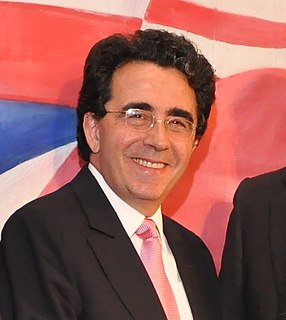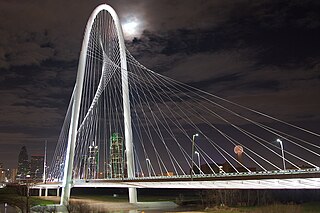
The Ponte Vecchio is a medieval stone closed-spandrel segmental arch bridge over the Arno River, in Florence, Italy. It is noted for the shops built along it; building shops on such bridges was once a common practice. Butchers, tanners, and farmers initially occupied the shops; the present tenants are jewelers, art dealers, and souvenir sellers. The Ponte Vecchio's two neighboring bridges are the Ponte Santa Trinita and the Ponte alle Grazie.

Santiago Calatrava Valls is a Spanish architect, structural engineer, sculptor and painter, particularly known for his bridges supported by single leaning pylons, and his railway stations, stadiums, and museums, whose sculptural forms often resemble living organisms. His best-known works include the Olympic Sports Complex of Athens, the Milwaukee Art Museum, the Turning Torso tower in Malmö, Sweden, the World Trade Center Transportation Hub in New York City, the Auditorio de Tenerife in Santa Cruz de Tenerife, the Margaret Hunt Hill Bridge in Dallas, Texas, and his largest project, the City of Arts and Sciences and Opera House in his birthplace, Valencia. His architectural firm has offices in New York City, Doha, and Zürich.

Ascoli Piceno is a town and comune in the Marche region of Italy, capital of the province of the same name. Its population is around 47,000 but the urban area of the city has more than 93,000.

Moncalieri is a town and comune of 56,134 inhabitants about 8 kilometres (5 mi) directly south of downtown Turin, in Piedmont, Italy. It is the most populous suburb of Turin and it is notable for its castle, built in the 12th century and enlarged in the 15th century, which later became the favorite residence of King Victor Emmanuel II of Italy and of his daughter Princess Maria Clotilde of Savoy. It is part of the World Heritage Site Residences of the Royal House of Savoy.

The Grand Canal is a channel in Venice, Italy. It forms one of the major water-traffic corridors in the city.

The City of Arts and Sciences is a cultural and architectural complex in the city of Valencia, Spain. It is the most important modern tourist destination in the city of Valencia and one of the 12 Treasures of Spain.

Rende is a city and comune in the province of Cosenza, Calabria, southern Italy, home to the headquarters of the University of Calabria. It has a population of about 35,000, or more than 60,000 if the university students living there are taken into account. It is divided in two parts: the old town, which is stands on a high hill, and the modern area, on level ground, which is connected to the city of Cosenza and with it is the centre of the economy of the province of Cosenza.

Cosenza is a city in Calabria, Italy. The city centre has a population of approximately 70,000; the urban area counts over 200,000 inhabitants. It is the capital of the Province of Cosenza, which has a population of over 700,000. The demonym of Cosenza in English is Cosentian.

The Strait of Messina Bridge is a long-planned suspension bridge across the Strait of Messina, that connects the cities of Messina’s Torre Faro and the port city of Villa San Giovanni in Calabria.

A cantilever spar cable-stayed bridge is a modern variation of the cable-stayed bridge. This design has been pioneered by the structural engineer Santiago Calatrava in 1992 with the Puente del Alamillo in Seville, Spain. In two of his designs the force distribution does not depend solely upon the cantilever action of the spar (pylon); the angle of the spar away from the bridge and the weight distribution in the spar serve to reduce the overturning forces applied to the footing of the spar. In contrast, in his swinging Puente de la Mujer design (2002), the spar reaches toward the cable supported deck and is counterbalanced by a structural tail. In the Assut de l'Or Bridge (2008), the curved backward pylon is back-stayed to concrete counterweights.

The Margaret Hunt Hill Bridge is a bridge in Dallas, Texas, that spans the Trinity River. The bridge is named for Margaret Hunt Hill, an heiress and philanthropist. The bridge was constructed as part of the Trinity River Project. Designed by Santiago Calatrava, it is one of three such bridges planned to be built over the Trinity; the second, the Margaret McDermott Bridge, is completed; the third cancelled. The span parallels the Ronald Kirk Bridge, a walking bridge that was previously the Continental Avenue bridge.
Acri is a town of 19.949 inhabitants in the northern part of Calabria region in southern Italy. Since 17 September 2001 Acri has had the "status" of city.

San Fili is a village and comune in the province of Cosenza in the Calabria region of southern Italy.

The Ponte della Costituzione is the fourth bridge over the Grand Canal in Venice, Italy. It was designed by Santiago Calatrava, and was moved into place in 2007, amid protest by politicians and the general public. The bridge was installed in 2008 and opened to the public on the night of September 11, 2008. The bridge was known as Quarto Ponte sul Canal Grande before the official name was adopted to celebrate the 60th anniversary of the Italian constitution in 2008. Tourists and locals in Venice now refer to it as the Calatrava Bridge.
Several bridges by the architect Santiago Calatrava are known locally as Calatrava bridge or Calatrava's bridge. These include:

The Salerno–Reggio Calabria railway is the most important north–south railway connection between Sicily, Calabria and the rest of the Italian peninsula. It forms the southern section of Corridor 1 of the European Union's Trans-European high-speed rail network, which connects Berlin and Palermo. Its southern part, between Rosarno and San Lucido is also used as an RFI freight route between the Port of Gioia Tauro and the Adriatic railway.
The following is a timeline of the history of the city of Taranto in the Apulia region of Italy.

The Ponte Girevole is a swing bridge in Taranto, Italy, spanning the navigation canal between Taranto's Mar Grande and the Mar Piccolo. The bridge connects Borgo Antico island to the Borgo Nuovo peninsula. The canal was excavated in 1481 as part of the defenses of Taranto. A steel and wood bridge was first built across the canal in 1886. The present steel bridge was built in 1958. Officially titled the Ponte di San Francesco di Paola, the bridge has two swing spans that pivot near the banks of the canal to meet in the middle of the canal. When open, the halves are parallel to the embankment, leaving the width of the canal clear for passage. The bridge is a Taranto landmark.

Ponte Morandi, officially Viadotto Polcevera, was a road viaduct in Genoa (Italy), constructed between 1963 and 1967 along Italy's A10 motorway over the Polcevera River, from which it derived its official name. The bridge was widely called "Ponte Morandi" after its structural designer, noted engineer Riccardo Morandi.

The Genoa Saint George Bridge is a motorway viaduct that crosses the Polcevera river and the districts of Sampierdarena and Cornigliano, in the city of Genoa. It was designed by architect Renzo Piano.


















